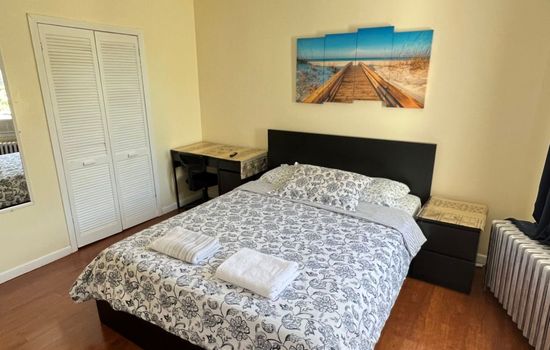The visitor center and museum are open Tuesday through Saturday from 10 AM to 4 PM, closed on Sundays, Mondays, and major holidays like Thanksgiving, Christmas, and New Year’s Day.
Admission to the African Burial Ground National Monument is free, with no entrance fee or pass required.
From New York City, exit FDR Drive at City Hall, proceed west to Broadway, and arrive at 290 Broadway, a historic nexus in Lower Manhattan.
No on-site parking. Nearest parking at 280 Broadway. No RV parking; motorcycles allowed at some lots. No overnight parking. Fees apply. Use public transport or ride-share for RVs.
Accessibility & permits
Emergency
- Cell service availability:None
Information not accurate?
Help us improve by making a suggestion.
In the heart of Lower Manhattan, the African Burial Ground National Monument stands as a poignant and historic site, a testament to the lives of thousands of Africans, both free and enslaved, who were laid to rest here from the mid-1630s to 1795. This sacred ground, spanning approximately 6.6 acres, is the nation’s earliest and largest known African burial site, a place where the vibrant cultural heritage of African Americans is deeply embedded.
Located at the intersection of Duane and Elk streets, the monument is part of the Civic Center area, its main building housed within the Ted Weiss Federal Building at 290 Broadway. The site is a remarkable archaeological find, with over 419 remains unearthed, and estimates suggest up to 20,000 burials may have taken place here. The careful excavation and study of this site have been hailed as the most important historic urban archaeological project in the United States.
As visitors walk through the memorial, they are met with a serene and reflective atmosphere, designed by architects Rodney Léon and Nicole Hollant Denis. The memorial includes several elements that honor African burial practices, such as the Ancestral Chamber and the Memorial Wall. The area is also surrounded by the bustling streets of New York City, a stark contrast to the peaceful reverence of the burial ground.
This national monument is more than a historical site; it is a living tribute to the community and resilience of the people buried here. Visitors can participate in guided tours and educational programs, gaining a deeper understanding of the significance of this place. The site hosts various events and ceremonies, particularly during Black History Month, which offer a chance to connect with the rich history and cultural importance of the African Burial Ground.
For those seeking a more immersive experience, the nearby area offers a blend of historical and modern attractions. The National Park Service provides detailed information and resources, while local businesses and artisans contribute to the vibrant cultural tapestry of the neighborhood. This monument is a must-visit for anyone interested in history, culture, and the profound impact of the African American community on the fabric of America.
- Area (mi²)
- 0.1
- Annual visitors
- 50 000
- Established year
- 2006
Top 3 Facts about African Burial Ground National Monument
The site, once a landfill, was rediscovered in 1991 during construction of a federal office building, leading to a 20-year excavation that uncovered a six-acre burial site containing the remains of over 419 individuals, with estimates suggesting up to 20,000 burials in the 17th and 18th centuries.
In the heart of Lower Manhattan, a serene memorial space contrasts with the bustling city. Here, a sequoia tree stands as a symbol of endurance, while the surrounding urban landscape is devoid of extensive wildlife. However, the site’s historical significance is underscored by its archaeological importance, rather than its natural flora and fauna. The absence of lakes or rivers means no fish, but the area’s tranquility is a haven for urban birds like pigeons and sparrows. This poignant memorial invites reflection on the lives of those buried here, adding a layer of depth to the city’s rich history.
This urban oasis is set against the backdrop of Lower Manhattan, where the Hudson River’s tranquil waters, with their hints of blue and green, contrast sharply with the bustling cityscape. The nearby skyscrapers stand tall, a stark juxtaposition to the historic grounds, which lie just a few blocks from the river’s edge, where temperatures can drop to around 25°F in winter and rise to 90°F in summer. The area’s unique blend of natural and man-made elements creates a compelling landscape that invites contemplation and exploration.
Family programs
- Junior Ranger
- Ranger-led Tours
- Self-guided Tours
- Workshops & Hands-on Activities
- Living History & Cultural Demos
- Scavenger Hunts
- Arts & Crafts
- Virtual Junior Activities.
Travel Tips
Plan Ahead
Visit from April to October for optimal weather. Reserve a ranger-led tour and plan for a memorable afternoon. Use public transport or ride-share, as parking is limited. Allow time for the visitor center and anticipate walking on paved paths. Pack meals, as on-site options are scarce.
Pack Appropriately
Pack light for a day trip: comfortable shoes, layers for varying weather, and a water bottle. For longer stays, bring camping gear and check seasonal weather forecasts. Respect the site’s solemn nature with appropriate attire.
Respect Wildlife
Respect the urban site by not disturbing the surrounding flora. Avoid littering and keep the area clean. No wildlife to interact with, focus on preserving the historical integrity of the site. Be mindful of weather conditions to avoid damaging the memorial. Leave the area as you found it.
Stay Informed
Be cautious on uneven surfaces and watch for changing weather conditions; in emergencies, call 911. Stay informed about park rules and weather updates.
Seasons
Visit in spring, when mild temperatures (50s-70s°F) and blooming flowers enhance the solemn beauty. Join the annual African Burial Ground Day in April for poignant ceremonies and reflections. A time for contemplation and historical connection.
In the sweltering summer months of June and July, with temperatures often reaching the mid-90s, this sacred site comes alive. Experience the Juneteenth celebrations, a poignant tribute to the Black experience, marked by rituals and presentations from 10 a.m. to 4 p.m. Despite the heat, the significance and cultural depth make it a compelling visit.
Visit in fall for crisp temperatures (50s-60s°F) and vibrant events. Attend the Triumph of the Human Spirit Day in October, featuring dance, drumming, and history lessons, set against the backdrop of golden autumn leaves. A poignant and enriching experience.
Visit from December to March, when crisp temperatures (30s-40s°F) and potential snow enhance the solemn beauty of the outdoor memorial, open until 4 PM, weather permitting. A serene winter backdrop for a poignant historical experience.
Information not accurate?
Help us improve by making a suggestion.
Where to stay
Frequently Asked Questions
Ready to dive into what African Burial Ground National Monument has to offer? Let’s tackle some of the burning questions you might have as you plan your visit!
-
You should stay in New York City to visit this site, which is located in lower Manhattan at 290 Broadway. The monument is easily accessible by multiple subway lines and is close to other historic sites like Federal Hall and the 9/11 Memorial.
-
Pets are not allowed inside the monument or the visitor center, except for designated service animals. Emotional support, therapy, comfort, or companion animals are not considered service animals. Airport-style security is in place for all visitors.
-
There is no on-site parking available. The closest parking options are located nearby, such as at 280 Broadway or 2 Lafayette Street in New York.
-
The Visitor Center is open from 10 AM to 4 PM, Tuesday through Saturday. It is closed on Sundays, Mondays, Thanksgiving Day, Christmas Day, and New Year’s Day. During summer months (May 7th through September 2nd), the outdoor memorial, but not the visitor center, remains open until 5 PM.



